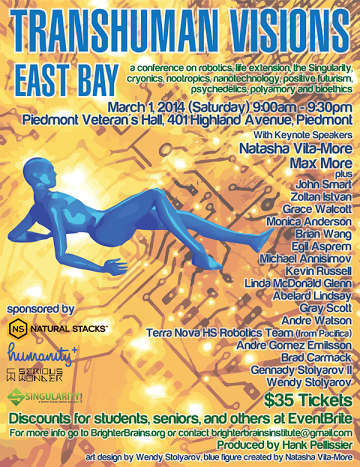Humanity could really use an upgrade.
At least, according to transhumanists it could.
Tranhumanism is a loosely defined movement to extend human physical and mental capabilities through technology. Sometimes abbreviated as humanity+ or H+, Transhumanism is represented by a growing faction of scientists, policymakers, and thinkers who believe in the use of technology to enhance human life at an individual level.
It's regarded by some as quackary, others as a religion. It's related to concepts as abstract as the Singularity and technologies as widespread and contemporary as your smartphone. It means different things to different people, but I personally like to think of it as "hacking the human condition".
This site is a whirlwind look at some of the people, technologies, and ideas that are part of the modern Transhumanism movement. It's open-source and under active development, so please let me know if you have any feedback.
“Transhumanism is a class of philosophies of life that seek the continuation and acceleration of the evolution of intelligent life beyond its currently human form and human limitations by means of science and technology, guided by life-promoting principles and values.”
Origins of Transhumanism
The term "transhumanism" was coined by the biologist Julian Huxley in 1927, in his essay Religion Without Revelation, in which he muses:
The human species can, if it wishes, transcend itself – not just sporadically, an individual here in one way, an individual there in another way – but in its entirety, as humanity. We need a name for this new belief. Perhaps transhumanism will serve: man remaining man, but transcending himself, by realizing new possibilities of and for his human nature.
The term later reappeared and gained popular recognition when Huxley used it as the title of his 1957 paper Transhumanism - a treatise on the potential of science, technology, and rationality to allow humanity to trancend it's current limitations and problems.
However, the roots of Transhumanism can be traced farther back than that, according to Nick Bostrom, a Philosophy professor at Oxford. In his article A History of Transhumanist Thought, Bostrom points to the myths of Gilgamesh's quest for immortality, tales of the Fountain of Youth, and early achemy as examples of Transhumanist ideas that are centuries old.
The transhumanist movement that is seen today began in the 1960s and 70s at schools like UCLA and the New School for Social Research in New York, where colorful figures like Max More and FM-2030 lectured about Transhumanist ideas and political theories. These early transhumanist groups and thinkers were mostly isolated, with similar interests and ideologies but no unified movement or worldview.

Humanity+ (previously the WTA), continues to hold conferences and events for the Transhumanist community.
Max More and Tom Morrow are arguably the two true creators of the modern unified transhumanist movement. In 1988, they published the first issue of Extropy Magazine, and in 1992 founded the Extropy Institute.Vjr. This had a unifying effect on the community, and the mailing list of the Extropy Institute was the first real forum for discussion within the greater Transhumanist community.
In 1998, Nick Bostrom founded the World Transhumanist Association (now known as Humanity+). This marked a transition for Transhumanism towards a more academic form more acceptable to those who did not frequent the Entropy Magazine discussion boards. After the founding of the WTA, Transhumanism gained more acceptance, with local chapters of the WTA forming worldwide and the scientific and academic community taking notice of the publications the WTA was producing. The WTA has since rebranded itself as Humanity+, but continues to run conferences, publish articles and an online magazine, and maintain a strong member base.
While the technologies and prominent figures in Transhumanism have changed since Huxley's time, the core purpose of the movement has remained the same: to make humans better.
“It's using the technology to provide something extra. It's enhancing. It's upgrading.”
Sensory Enhancement
One of the most promising (and controversial) ways that Transhumanists are trying to make humans better is by augmenting the human senses. Technologies like cochlear implants and artificial retinas are used to allow the deaf and blind to hear and see - it's not that much of a stretch to imagine advanced versions of these technologies being used by non-impaired humans to extend their visual and auditory capabilities. Below is a gallery of some of the most promising sensory research and development - technologies that have the potential to change how humans experience the world.
Tech Gallery

Argus II Retinal Prosthesis
The Argus II is a system developed by Second Sight that pairs a head-mounted camera with a special implant. It allows some blind patients to regain some of their vision by bypassing damaged photoreceptors in their eyes and sending a signal straight to their optic nerve. Eventually, similar technologies could give humans enhanced vision.OTw

FeelSpace Belt
The FeelSpace Belt is a device that uses sensory substitution to give users a sense of magnetic direction via haptic feedback. It's a compass hooked up to a set of vibrating motors that the user wears around their waist. It was the subject of a study that found that the device is effective at giving users a "sixth sense" for magnetic direction. xGl

Northpaw
Northpaw is a DIY sensory extension device by the transhumanist group Sensebridge. It's similar to the FeelSpace belt but is ankle-mounted instead of being worn on the user's waist. It represents the "grinder" movement - a loosely affiliated group of artists and transhumanists who use consumer-available electronics and hardware to pursue transhumanist aims, DIY-style.uf8

Eyeborg
The eyeborg is a device created to allow Neil Harbisson, born colorblind, to percieve color. It's another sensory substitution device that translates wavelengths of light into audio. Originally it was limited to the visible spectrum, but with the latest version Harbisson is capable of percieving colors in the infrared and ultraviolet range.s9P
“Illness and aging affect all our families. With some longer term, moonshot thinking around healthcare and biotechnology, I believe we can improve millions of lives.”
Life Extension
Life extension is currently one of the most actively researched areas of transhumanism, due to its almost universal appeal and the abundance of funding for medical research. Though life extension technologies all share the same goal of prolonging individual human existience, they often take very different approaches in their attempts to achieve that goal.
Alcor
Alcor, founded in 1972, is one of the oldest organizations out there pursuing life extension technologies. However, the Alcor approach is perhaps the most forward-thinking (and speculative!). Alcor specializes in cryonics, with the idea being to cryogenically preserve people who have terminal illnesses or whose bodies are too old to sustain them until technology that can revive and cure them is developed.
There are a problems with this strategy – chief among them being the fact that it is technically murder to freeze a living person. For this reason, Alcor is limited to freezing individuals just after they are pronounced legally dead. The long-term tenability of cryogenics for a healthy person is very much under debate, so the fact that all of Alcor's 123 patients are technically dead draws a lot of skepticism from the press and academic community.
Google Calico
One of the newest and possibly biggest players in life extension research is the California Life Company, or Google Calico. Announced by Larry Page last year, Calico "will focus on health and well-being, in particular the challenge of aging and associated diseases" Ky5. Calico is an example of "moonshot" or "10x" thinking - a favorite term of Google describing incredibly ambitious projects (like the Apollo Moon landing program) that challenge traditional thinking by pursuing technological gains that are an order of magnitude better than existing technology.
“Are people really focused on the right things?” Page muses in the interview. “One of the things I thought was amazing is that if you solve cancer, you’d add about three years to people’s average life expectancy. We think of solving cancer as this huge thing that’ll totally change the world, but when you really take a step back and look at it, yeah, there are many, many tragic cases of cancer, and it’s very, very sad, but in the aggregate, it’s not as big an advance as you might think.” Wg7
In short, Calico is exciting because it isn't aiming to cure specific diseases or health problems. It's looking to cure aging, and it's backed by one of the biggest and most innovative companies of our time.
Other projects of note
While Google Calico and Alcor are probably the most public examples of organizations pursuing life extension technologies, there are a myriad of other independent researchers and smaller organizations working to solve the problems associated with aging and disease. In fact, you could say that life extension is the most prevalent form of transhumanism in practice today, since very pharmaceutical company and research hospital is effectively conducting life extension research every day (albeit in a slightly more traditional way than Google or Alcor). Here are some of the key areas of interest that are being studied right now:
Regardless of the methodology, life extension research brings up many interesting philosophical and ethical issues that are the source of much of the controversy surrounding transhumanism. Questions like how life extension will affect overpopulation, whether an uploaded mind counts as a person, and the ethics of cryogenically preserving a terminally ill patient don't have obvious answers or solutions. How we chose to think about and address those questions will have huge impacts on the future of life extension and transhumanism.
“cognitive enhancement has much to offer individuals and society, and a proper societal response will involve making enhance- ments available while managing their risks”
Cognitive Enhancement
The age of cognitive enhancement drugs is already here. Executives and students take Adderall to stay sharp, writers take stimulants to meet deadlines, and the military pours millions of dollars into drugs to enhance soldiers' and pilots' cognitive abilities under battlefield conditions. fl5. While off-label use of perscription drugs for cognitive enhancement definitely has a stigma attached to it, Henry Greely and his co-authors for a recent Nature commentary argue that "Society must respond to the growing demand for cognitive enhancement. That response must start by rejecting the idea that ‘enhancement’ is a dirty word" BlJ.
In his article, Greely points out that cognitive enhancement drugs are here to stay, citing statistics on their usage by young people:
“...one survey estimated that almost 7% of students in US universities have used prescription stimulants in this way, and that on some campuses, up to 25% of students had used them in the past year. These students are early adopters of a trend that is likely to grow, and indications suggest that they’re not alone.” BlJ
While doping in sports can be banned and tested for, that isn't a possibility in the offices and college campuses across the world. Are students and workers taking cognitive enhancement drugs giving themselves an unfair advantage? Or this just the next evolution in a long lineage of technologies going all the way back to the wheel that have enhanced human capabilities through "unnatural" means?
Cognitive enhancement is a promising but fundamentally controverisal area of tranhumanism that's constantly changing. While drugs like Adderall and Ritalin are widespread in their use today, current research suggests that even more effective and futuristic strategies for cognitive enhancement are on the horizon - things like brain-stimulating electrodes and implants EBd, bGc. These drugs and devices have the potential to transform the way we think about nootropics and health technologies for the healthy.
“But when the technology works, when it can make you stronger or faster than you were, it overnight becomes sexy and powerful and threatening. Overnight.”
Physical Enhancement
It comes as no surprise that the biggest driving force behind increasing humans' physical capabilities is the US Department of Defense. A 2002 report commissioned by the US Government suggests that provides a broad overview of transhumanist technologies and suggests that many of them have potential military applications. An Army-funded initiative called the Institute for Soldier Nanotechnologies aims to "discover and field technologies that dramatically advance Soldier protection and survivability capabilities." Human physical enhancement is on its way in, due in no small part to the immense amount of funding and interest that the US military is throwing at this area of research.
Despite the fact that most physical enhancement research is funded by military backers, many of the technologies in development have great potential for civilian use.
Tech Gallery

Night Vision Contacts
The University of Michigan is developing a set of contacts that use graphene nanomaterials to multiply light and effectively give their wearer enhanced night vision.

Titan Exoskeleton
Researchers at the University of Pennsylvania are designing an upper body exoskeleton to dramatically increase the strength of the user.

ReWalk
The ReWalk is another exoskeleton project aimed at patients with disabled lower body motor systems. With it, paralyzed patients can walk upright with the help of crutches

Oscar Pistorius
One of the most dramatic examples of the potential of prosthetics to exceed the abilities of natural limbs, Oscar Pistorius became the first runner to compete in both the Paralympics and Olympics, amidst complaints that his distinctive blade-style artificial legs gave him an unfair advantage.
“hey, let’s try to do something completely crazy on the internet that nobody’s done.”
Transhumanism in the Media
While transhumanism has been on the radar of academics for years, only recently has it become a media staple. Projects like H+, The Digital Series Bzm and blockbusters like Transcendence have brought transhumanist ideas into the forefront of the public imagination
The upswing in media coverage is significant to transhumanism as it resonates with the movement's history. Transhumansim in its modern form came about because colorful people like Max More, Tom Morrow, and FM-2030 were inspired to dream big and ask "what if?". More exposure for the movement and its ideas through modern media is likely to spark a whole new generation of transhumanist thinkers.
“We are all cyborgs now”
The Future of Transhumanism
The future of transhumanism is reflected clearly in our daily lives. Every time we check the weather on our smartphone, every new ability we gain from advances in medicine, and every new connection forged via technology is a reminder that we are already part transhuman.
Technology is going to continue to reshape our lives and ultimately the human condition. Those changes are probably going to be wildly different from any of the things we can predict today - "moonshots" like Google Calico that no one is going to see coming. However, one thing is certain: as a society, we need to not shy away from discussing the practical and ethical implications of these technologies. While technology has the potential to change our lives in a myriad of ways, it is our humanity that will determine whether those changes are for good or ill.
References
- RfK Transhumanism – Wikipedia
- Vjr A History of Transhumanist Thought - Nick Bostrom
- cVc Transhumanism - Julian Huxley (1957)
- OTw Argus II Retinal Prosthesis System - Second Sight
- uf8 Northpaw - Sensebridge
- xGl FeelSpace Belt - Feelspace
- s9P Homepage - The Cyborg Foundation
- Ky5 Google Calico Announcement – Larry Page
- Wg7 Google Calico Interview – TechCrunch
- msX Anti-Aging drugs – Wikipedia
- 84e The next frontier in 3-D printing: Human organs – CNN
- sGD Medical Nanotech – Medical Daily
- Okj Mind Uploading – Wikipedia
- BlJ Towards responsible use of cognitive-enhancing drugs by the healthy – Nature
- fl5 Popping Smart Pills: The Case for Cognitive Enhancement – TIME
- EBd Brain implants: Because you’ve always wanted to think more like Einstein – Washington Post
- bGc Here’s how we should regulate brain enhancement devices – Washington Post
- Bzm John Cabrera Interview – Modern Mythology
- 1Uz We are all cyborgs now – Amber Case
- JQB Bionic Legs, I-limbs, and Other Super Human Prostheses You'll Envy – Fast Company
Additional Reading
- Future Minds: Transhumanism, Cognitive Enhancement and the Nature of Persons – Susan Schneider
- Engineering Extra Senses – NOVA
- Mixed Feelings – WIRED
- Choose Your Own Sixth Sense – Slate
- K. Warwick, B. Hutt, M. Gasson and I. Goodhew, "An attempt to extend human sensory capabilities by means of implant technology"
- K. Warwick - The Promise and Threat of Modern Cybernetics. (Southern Medical Journal, Jan. 2007)